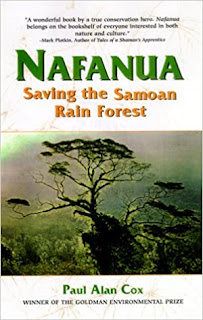I heard about this book in the Living Books of All Peoples group on Facebook, a fantastic group with a treasure trove of information not just about books, but about how to learn about and appreciate other people and cultures.
The author is an ethnobiologist who first visited the Samoan islands as a missionary for the Church of Jesus Christ of Latter-Day Saints. He learned a great deal in his time as a missionary and returned years later to examine specimens of the rainforest in search of new sources of treatment for cancer by studying with local herbal medicine authorities.
This book is bursting with knowledge about the environment of the Samoan islands, but also their culture and history. He includes quotations from European travelers, scholars, and missionaries to show how they misunderstood (or understood) the islanders.
The book is very much Dr. Cox's own personal story, sharing his fears about influencing the island culture and his concerns later for how his involvement changes the forest and the people when he and others seek to protect parts of the forest for the benefit of the environment. Though it is written from the perspective of an American, it is an excellent introduction to the Samoan people for those of us who will never have the chance to travel there and live within a tightly knit village, as his family did. His own trepidations about blending cultures speak eloquently to the same tensions in our world today.
Dr. Cox's own strong faith is ever-present in the book. He writes respectfully about those of other faiths, including the many Catholics in his village.
Some of my scientific colleagues have gently asked whether my devotion to Christianity is compatible with advocacy of indigenous rights and preservation of indigenous cultures. Given the checkered record of missionary interactions with indigenous people, particularly in Polynesia, it is a perfectly reasonable question, and I try to respond with candor: I am committed to my faith. In my ethnobotanical work I do not seek to preach my faith to indigenous people, but I believe that my religious commitment facilitates a more empathetic response to indigenous approaches to the divine. (p. 36)
This was a truly wonderful book. It's a remarkably exciting story that reveals how difficult it is to immerse yourself in another culture because you also always remain who you were before, while showing how we can protect the livelihoods and cultures of those most vulnerable by listening to their stories and learning to love who they are.
"Is there a permanent solution for the rain forest?" I'm sometimes asked. "Yes," I reply, "cut it down. Then it will never grow back and you won't have to worry about it again. But if you want to save it, each day you have to decide not to destroy it, and must trust that others will reaffirm that decision after you have left the scene." (p. 183)
Dr. Cox is one of the co-founders of Seacology, a non-profit organization that works with island communities. It grew out of his desire to protect the rainforest of Falealupo, a story he tells in the book.
This is an excellent book to consider for high school geography of the Pacific Islands. It will definitely be on our list.
I have received nothing in exchange for this post. Links to Amazon and Bookshop are affiliate links. I received this book from a member of PaperBackSwap.com (not an affiliate link).

